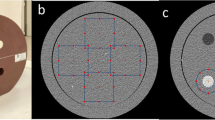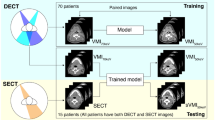Abstract
Purpose
We assessed the physical properties of virtual monochromatic images (VMIs) obtained with different energy levels in various contrast settings and radiation doses using deep learning-based spectral computed tomography (DL-Spectral CT) and compared the results with those from single-energy CT (SECT) imaging.
Materials and methods
A Catphan® 600 phantom was scanned by DL-Spectral CT at various radiation doses. We reconstructed the VMIs obtained at 50, 70, and 100 keV. SECT (120 kVp) images were acquired at the same radiation doses. The standard deviations of the CT number and noise power spectrum (NPS) were calculated for noise characterization. We evaluated the spatial resolution by determining the 10% task-based transfer function (TTF) level, and we assessed the task-based detectability index (d’).
Results
Regardless of the radiation dose, the noise was the lowest at 70 keV VMI. The NPS showed that the noise amplitude at all spatial frequencies was the lowest among other VMI and 120 kVp images. The spatial resolution was higher for 70 keV VMI compared to the other VMIs, except for high-contrast objects. The d’ of 70 keV VMI was the highest among the VMI and 120 kVp images at all radiation doses and contrast settings. The d’ of the 70 keV VMIs at the minimum dose was higher than that at the maximum dose in any other image.
Conclusion
The physical properties of the DL-Spectral CT VMIs varied with the energy level. The 70 keV VMI had the highest detectability by far among the VMI and 120-kVp images. DL-Spectral CT may be useful to reduce radiation doses.







Similar content being viewed by others
References
Thieme SF, Graute V, Nikolaou K, Maxien D, Reiser MF, Hacker M, et al. Dual energy CT lung perfusion imaging—Correlation with SPECT/CT. Eur J Radiol. 2012;81:360–5.
Hu R, Daftari Besheli L, Young J, Wu M, Pomerantz S, Lev MH, et al. Dual-energy head CT enables accurate distinction of intraparenchymal hemorrhage from calcification in emergency department patients. Radiology. 2016;280:177–83.
Lee SH, Lee JM, Kim KW, et al. Dual-energy computed tomography to assess tumor response to hepatic radiofrequency ablation: potential diagnostic value of virtual noncontrast images and iodine maps. Invest Radiol. 2011;46:77–84.
Shuman WP, Chan KT, Busey JM, Mitsumori LM, Koprowicz KM. Dual-energy CT aortography with 50% reduced iodine dose versus single-energy CT aortography with standard iodine dose. Acad Radiol. 2016;23:611–8.
Bhosale P, Le O, Balachandran A, Fox P, Paulson E, Tamm E. Quantitative and qualitative comparison of single-source dual-energy computed tomography and 120-kVp computed tomography for the assessment of pancreatic ductal adenocarcinoma. J Comput Assist Tomogr. 2015;39:907–13.
Mileto A, Nelson RC, Samei E, Jaffe TA, Paulson EK, Barina A, et al. Impact of dual-energy multi-detector row CT with virtual monochromatic imaging on renal cyst pseudoenhancement: in vitro and in vivo study. Radiology. 2014;272:767–76.
Sugawara H, Takayanagi T, Ishikawa T, Katada Y, Fukui R, Yamamoto Y, et al. New fast kVp switching dual-energy CT: Reduced severity of beam hardening artifacts and improved image quality in reduced-iodine virtual monochromatic imaging. Acad Radiol. 2019;27:1586–93. https://doi.org/10.1016/j.acra.2019.11.015.
Ohira S, Karino T, Ueda Y, Nitta Y, Kanayama N, Miyazaki M, et al. How well does dual-energy CT with fast kilovoltage switching quantify CT number and iodine and calcium concentrations? Acad Radiol. 2018;25:519–28.
Washio H, Ohira S, Karino T, Nitta Y, Hayashi M, Miyazaki M, et al. Accuracy of quantification of iodine and hounsfield unit values on virtual monochromatic imaging using dual-energy computed tomography: comparison of dual-layer computed tomography with fast kilovolt-switching computed tomography. J Comput Assist Tomogr. 2018;42:965–71.
Boedeker K, Hayes M, Zhou J, Zhang R, Yu Z. Whitepaper: Deep learning spectral CT– Faster, easier and more intelligent. 2019. Available at: https://global.medical.canon/products/computed-tomography/spectral. Accessed 13 November 2022.
Kojima T, Shirasaka T, Kondo M, Kato T, Nishie A, Ishigami K, et al. A novel fast kilovoltage switching dual-energy CT with deep learning: accuracy of CT number on virtual monochromatic imaging and iodine quantification. Phys Med. 2021;81:253–61.
GOV. UK. Guidance National Diagnostic Reference Levels (NDRLs) from 19 August 2019. Available at: https://www.gov.uk/government/publications/diagnostic-radiology-national-diagnostic-reference-levels-ndrls/ndrl. Accessed 10 May 2022.
Samei E, Bakalyar D, Boedeker KL, Brady S, Fan J, Leng S, et al. Performance evaluation of computed tomography systems: Summary of AAPM Task Group 233. Med Phys. 2019;46:e735–56.
Samei E, Richard S. Assessment of the dose reduction potential of a model-based iterative reconstruction algorithm using a task-based performance metrology. Med Phys. 2015;42:314–23.
Shirasaka T, Kojima T, Funama Y, Sakai Y, Kondo M, Mikayama R, et al. Image quality improvement with deep learning-based reconstruction on abdominal ultrahigh-resolution CT: a phantom study. J Appl Clin Med Phys. 2021;22:286–96.
Boedeker KL, Cooper VN, McNitt-Gray MF. Application of the noise power spectrum in modern diagnostic MDCT: part I. measurement of noise power spectra and noise equivalent quanta. Phys Med Biol. 2007;52:4027–46.
Urikura A, Ichikawa K, Hara T, Nishimaru E, Nakaya Y. Spatial resolution measurement for iterative reconstruction by use of image-averaging techniques in computed tomography. Radiol Phys Technol. 2014;7:358–66.
Richard S, Husarik DB, Yadava G, Murphy SN, Samei E. Towards task-based assessment of CT performance: system and object MTF across different reconstruction algorithms. Med Phys. 2012;39:4115–22.
Greffier J, Si-Mohamed S, Dabli D, de Forges H, Hamard A, Douek P, et al. Performance of four dual-energy CT platforms for abdominal imaging: a task-based image quality assessment based on phantom data. Eur Radiol. 2021;31:5324–34.
Eckstein M, Bartroff J, Abbey C, Whiting J, Bochud F. Automated computer evaluation and optimization of image compression of x-ray coronary angiograms for signal known exactly detection tasks. Opt Express. 2003;11:460–75.
Greffier J, Frandon J, Larbi A, Beregi JP, Pereira F. CT iterative reconstruction algorithms: a task-based image quality assessment. Eur Radiol. 2020;30:487–500.
Greffier J, Larbi A, Frandon J, Moliner G, Beregi JP, Pereira F. Comparison of noise-magnitude and noise-texture across two generations of iterative reconstruction algorithms from three manufacturers. Diagn Interv Imaging. 2019;100:401–10.
Ehman EC, Yu L, Manduca A, Hara AK, Shiung MM, Jondal D, et al. Methods for clinical evaluation of noise reduction techniques in abdominopelvic CT. Radiographics. 2014;34:849–62.
Geyer LL, Schoepf UJ, Meinel FG, Nance JW, J, Bastarrika G, Leipsic JA, et al. State of the art: iterative CT reconstruction techniques. Radiology. 2015;276:339–57.
Author information
Authors and Affiliations
Corresponding author
Ethics declarations
Conflict of interest
The authors declare that they have no known competing financial interests or personal relationships that could have appeared to influence the work reported in this paper.
Additional information
Publisher's Note
Springer Nature remains neutral with regard to jurisdictional claims in published maps and institutional affiliations.
Supplementary Information
Below is the link to the electronic supplementary material.
About this article
Cite this article
Katsuyama, Y., Kojima, T., Shirasaka, T. et al. Characteristics of the deep learning-based virtual monochromatic image with fast kilovolt-switching CT: a phantom study. Radiol Phys Technol 16, 77–84 (2023). https://doi.org/10.1007/s12194-022-00695-x
Received:
Revised:
Accepted:
Published:
Issue Date:
DOI: https://doi.org/10.1007/s12194-022-00695-x




